Business Administration Report: Leadership and Management at M&S
VerifiedAdded on 2020/10/23
|15
|4214
|90
Report
AI Summary
This report provides a comprehensive analysis of leadership and management practices within Marks & Spencer (M&S). It begins by emphasizing the importance of defining objectives, scope, and success criteria in decision-making, alongside the need to analyze the potential impact of decisions and validate information. The report then delves into the differences between managers and leaders, evaluating the suitability and impact of various leadership styles, such as participative and supportive approaches, in different contexts. It explores motivation theories, including Herzberg's Two-Factor Theory, and their application in the workplace. Furthermore, the report examines a manager's responsibilities for planning, coordinating, and controlling work, and how managers ensure that team objectives are met. It discusses the alignment of decisions with business objectives, values, and policies, as well as the importance of setting key performance indicators (KPIs) and utilizing performance measurement systems to monitor and report on business performance. Finally, it highlights the relationship between business objectives and performance measures, including the use of management accounts and information systems.
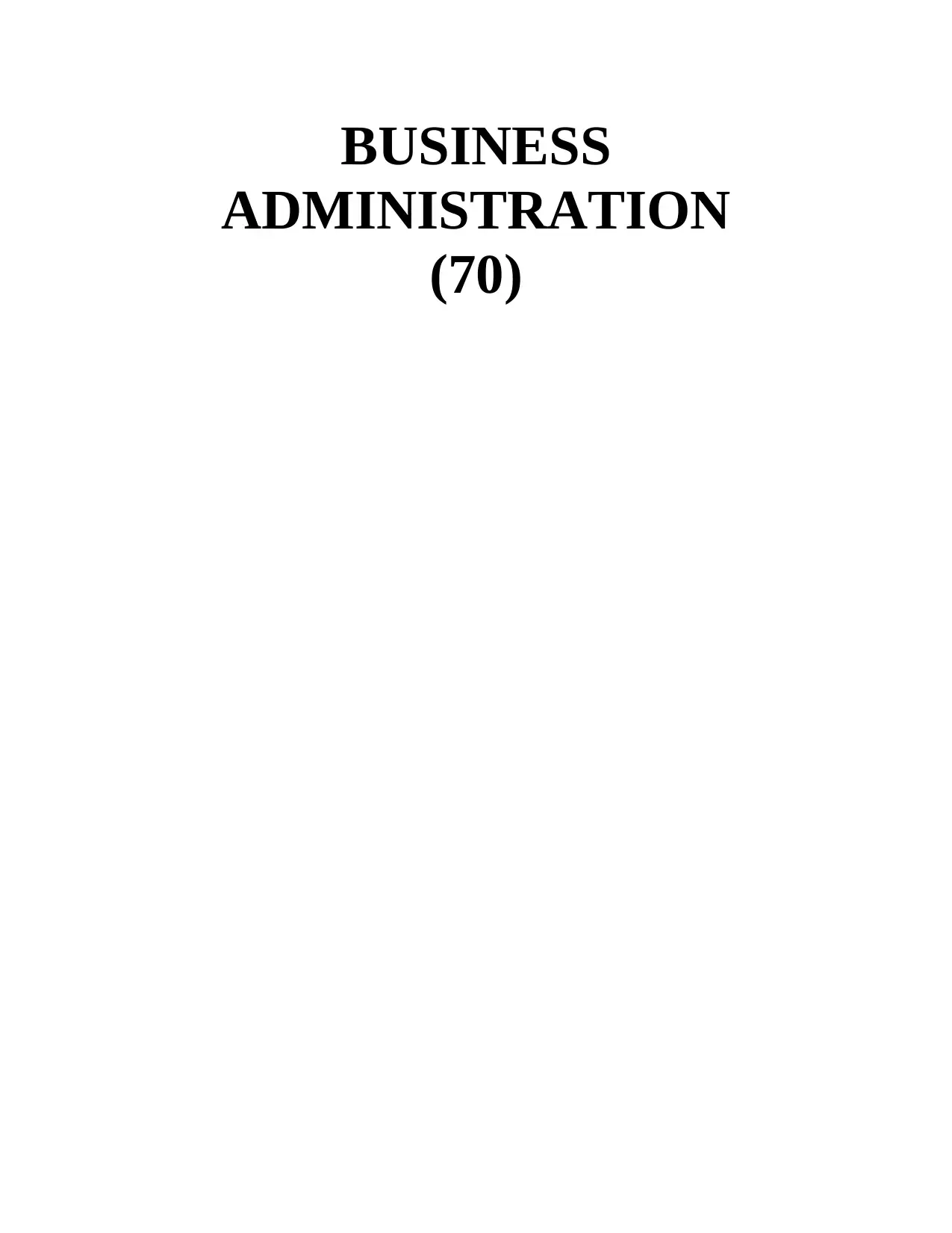
BUSINESS
ADMINISTRATION
(70)
ADMINISTRATION
(70)
Paraphrase This Document
Need a fresh take? Get an instant paraphrase of this document with our AI Paraphraser
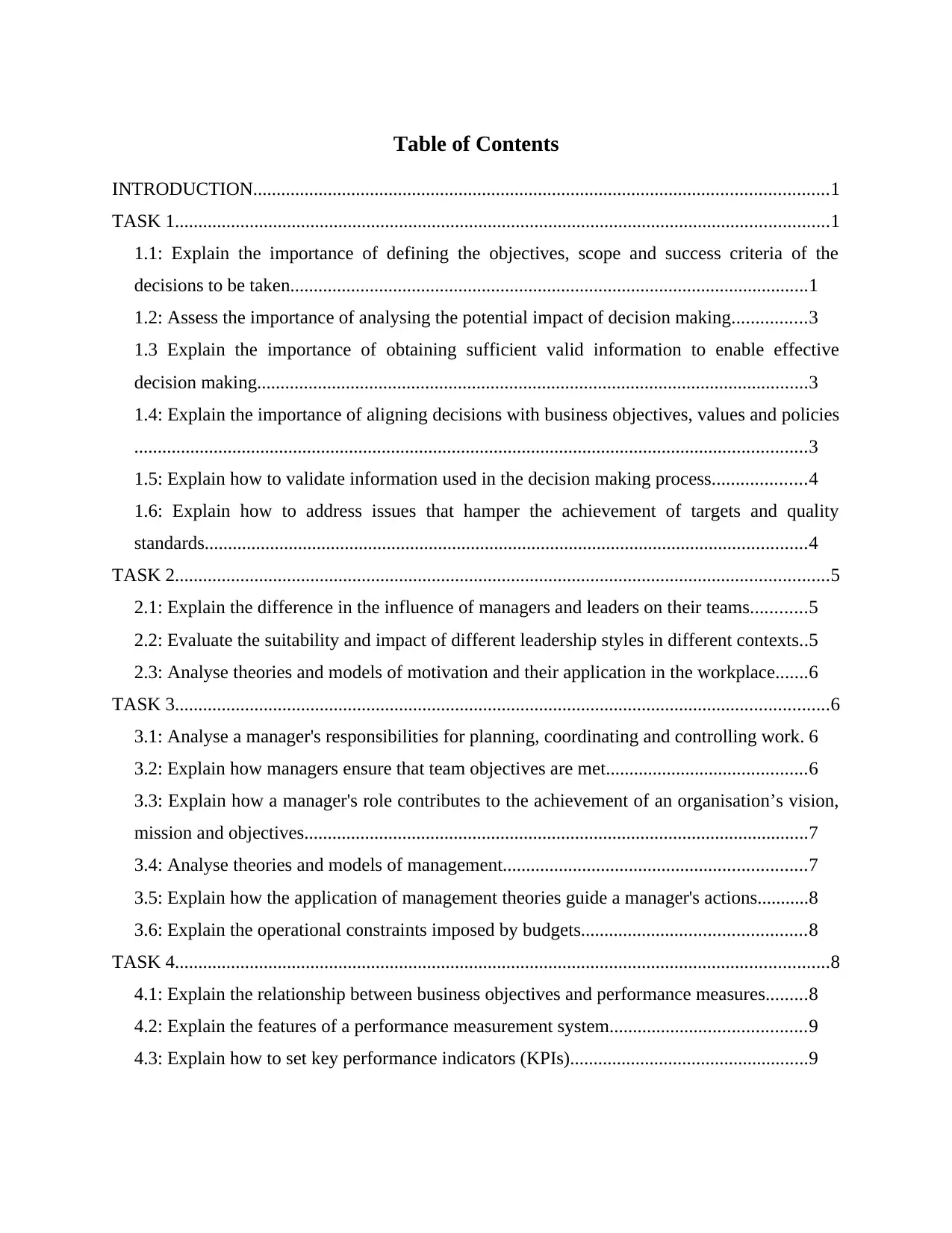
Table of Contents
INTRODUCTION...........................................................................................................................1
TASK 1............................................................................................................................................1
1.1: Explain the importance of defining the objectives, scope and success criteria of the
decisions to be taken...............................................................................................................1
1.2: Assess the importance of analysing the potential impact of decision making................3
1.3 Explain the importance of obtaining sufficient valid information to enable effective
decision making......................................................................................................................3
1.4: Explain the importance of aligning decisions with business objectives, values and policies
................................................................................................................................................3
1.5: Explain how to validate information used in the decision making process....................4
1.6: Explain how to address issues that hamper the achievement of targets and quality
standards.................................................................................................................................4
TASK 2............................................................................................................................................5
2.1: Explain the difference in the influence of managers and leaders on their teams............5
2.2: Evaluate the suitability and impact of different leadership styles in different contexts..5
2.3: Analyse theories and models of motivation and their application in the workplace.......6
TASK 3............................................................................................................................................6
3.1: Analyse a manager's responsibilities for planning, coordinating and controlling work. 6
3.2: Explain how managers ensure that team objectives are met...........................................6
3.3: Explain how a manager's role contributes to the achievement of an organisation’s vision,
mission and objectives............................................................................................................7
3.4: Analyse theories and models of management.................................................................7
3.5: Explain how the application of management theories guide a manager's actions...........8
3.6: Explain the operational constraints imposed by budgets................................................8
TASK 4............................................................................................................................................8
4.1: Explain the relationship between business objectives and performance measures.........8
4.2: Explain the features of a performance measurement system..........................................9
4.3: Explain how to set key performance indicators (KPIs)...................................................9
INTRODUCTION...........................................................................................................................1
TASK 1............................................................................................................................................1
1.1: Explain the importance of defining the objectives, scope and success criteria of the
decisions to be taken...............................................................................................................1
1.2: Assess the importance of analysing the potential impact of decision making................3
1.3 Explain the importance of obtaining sufficient valid information to enable effective
decision making......................................................................................................................3
1.4: Explain the importance of aligning decisions with business objectives, values and policies
................................................................................................................................................3
1.5: Explain how to validate information used in the decision making process....................4
1.6: Explain how to address issues that hamper the achievement of targets and quality
standards.................................................................................................................................4
TASK 2............................................................................................................................................5
2.1: Explain the difference in the influence of managers and leaders on their teams............5
2.2: Evaluate the suitability and impact of different leadership styles in different contexts..5
2.3: Analyse theories and models of motivation and their application in the workplace.......6
TASK 3............................................................................................................................................6
3.1: Analyse a manager's responsibilities for planning, coordinating and controlling work. 6
3.2: Explain how managers ensure that team objectives are met...........................................6
3.3: Explain how a manager's role contributes to the achievement of an organisation’s vision,
mission and objectives............................................................................................................7
3.4: Analyse theories and models of management.................................................................7
3.5: Explain how the application of management theories guide a manager's actions...........8
3.6: Explain the operational constraints imposed by budgets................................................8
TASK 4............................................................................................................................................8
4.1: Explain the relationship between business objectives and performance measures.........8
4.2: Explain the features of a performance measurement system..........................................9
4.3: Explain how to set key performance indicators (KPIs)...................................................9
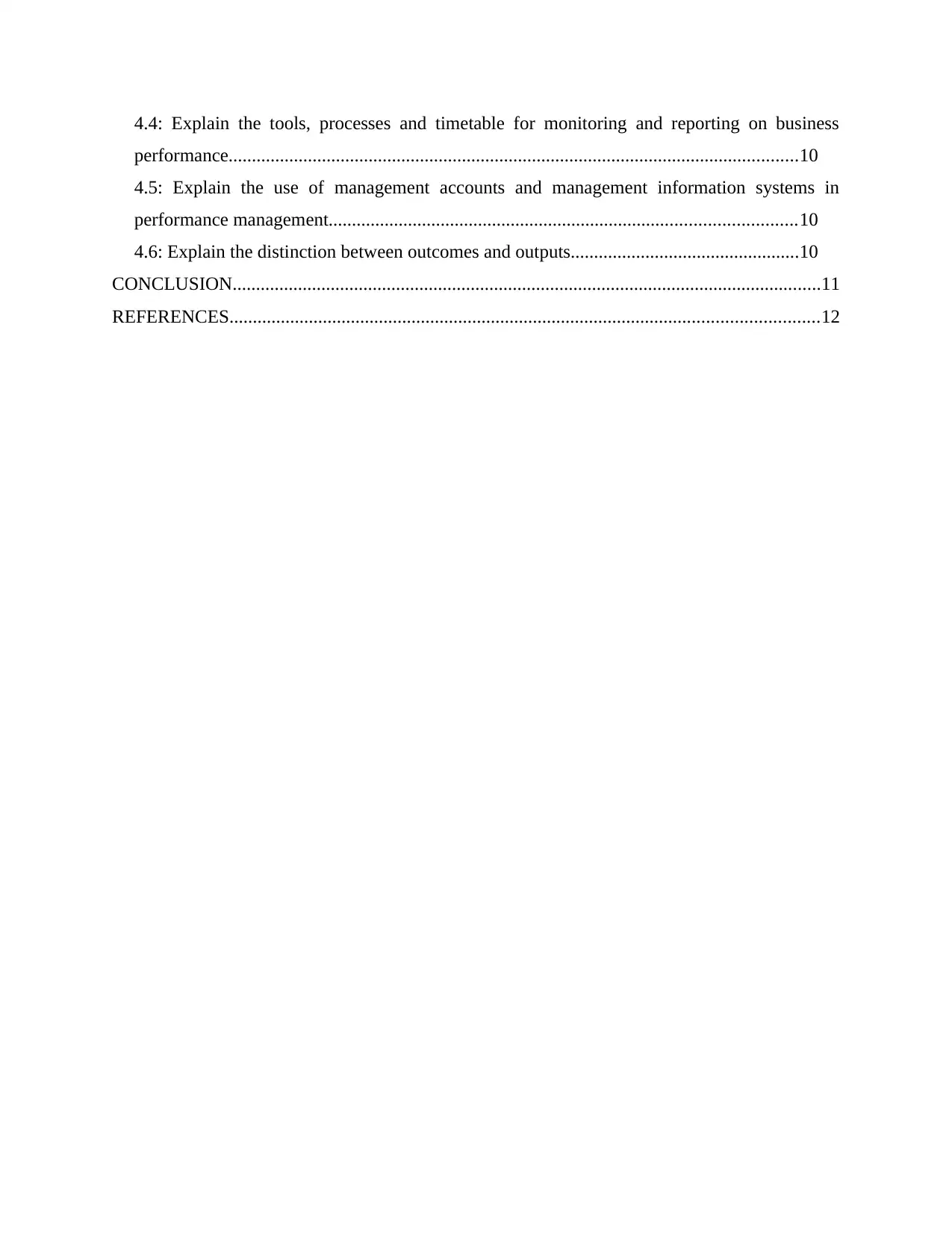
4.4: Explain the tools, processes and timetable for monitoring and reporting on business
performance..........................................................................................................................10
4.5: Explain the use of management accounts and management information systems in
performance management....................................................................................................10
4.6: Explain the distinction between outcomes and outputs.................................................10
CONCLUSION..............................................................................................................................11
REFERENCES..............................................................................................................................12
performance..........................................................................................................................10
4.5: Explain the use of management accounts and management information systems in
performance management....................................................................................................10
4.6: Explain the distinction between outcomes and outputs.................................................10
CONCLUSION..............................................................................................................................11
REFERENCES..............................................................................................................................12
⊘ This is a preview!⊘
Do you want full access?
Subscribe today to unlock all pages.

Trusted by 1+ million students worldwide
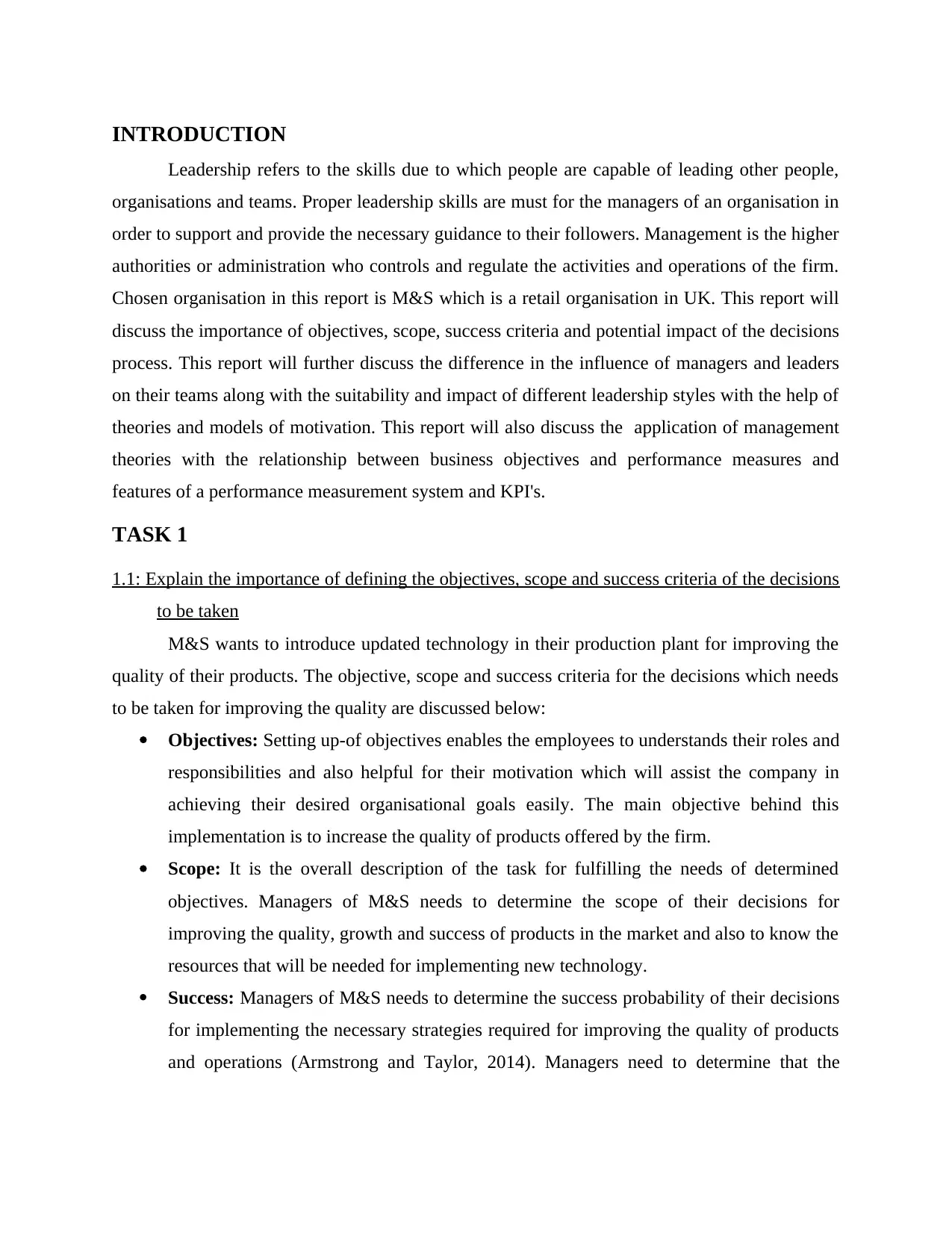
INTRODUCTION
Leadership refers to the skills due to which people are capable of leading other people,
organisations and teams. Proper leadership skills are must for the managers of an organisation in
order to support and provide the necessary guidance to their followers. Management is the higher
authorities or administration who controls and regulate the activities and operations of the firm.
Chosen organisation in this report is M&S which is a retail organisation in UK. This report will
discuss the importance of objectives, scope, success criteria and potential impact of the decisions
process. This report will further discuss the difference in the influence of managers and leaders
on their teams along with the suitability and impact of different leadership styles with the help of
theories and models of motivation. This report will also discuss the application of management
theories with the relationship between business objectives and performance measures and
features of a performance measurement system and KPI's.
TASK 1
1.1: Explain the importance of defining the objectives, scope and success criteria of the decisions
to be taken
M&S wants to introduce updated technology in their production plant for improving the
quality of their products. The objective, scope and success criteria for the decisions which needs
to be taken for improving the quality are discussed below:
Objectives: Setting up-of objectives enables the employees to understands their roles and
responsibilities and also helpful for their motivation which will assist the company in
achieving their desired organisational goals easily. The main objective behind this
implementation is to increase the quality of products offered by the firm.
Scope: It is the overall description of the task for fulfilling the needs of determined
objectives. Managers of M&S needs to determine the scope of their decisions for
improving the quality, growth and success of products in the market and also to know the
resources that will be needed for implementing new technology.
Success: Managers of M&S needs to determine the success probability of their decisions
for implementing the necessary strategies required for improving the quality of products
and operations (Armstrong and Taylor, 2014). Managers need to determine that the
Leadership refers to the skills due to which people are capable of leading other people,
organisations and teams. Proper leadership skills are must for the managers of an organisation in
order to support and provide the necessary guidance to their followers. Management is the higher
authorities or administration who controls and regulate the activities and operations of the firm.
Chosen organisation in this report is M&S which is a retail organisation in UK. This report will
discuss the importance of objectives, scope, success criteria and potential impact of the decisions
process. This report will further discuss the difference in the influence of managers and leaders
on their teams along with the suitability and impact of different leadership styles with the help of
theories and models of motivation. This report will also discuss the application of management
theories with the relationship between business objectives and performance measures and
features of a performance measurement system and KPI's.
TASK 1
1.1: Explain the importance of defining the objectives, scope and success criteria of the decisions
to be taken
M&S wants to introduce updated technology in their production plant for improving the
quality of their products. The objective, scope and success criteria for the decisions which needs
to be taken for improving the quality are discussed below:
Objectives: Setting up-of objectives enables the employees to understands their roles and
responsibilities and also helpful for their motivation which will assist the company in
achieving their desired organisational goals easily. The main objective behind this
implementation is to increase the quality of products offered by the firm.
Scope: It is the overall description of the task for fulfilling the needs of determined
objectives. Managers of M&S needs to determine the scope of their decisions for
improving the quality, growth and success of products in the market and also to know the
resources that will be needed for implementing new technology.
Success: Managers of M&S needs to determine the success probability of their decisions
for implementing the necessary strategies required for improving the quality of products
and operations (Armstrong and Taylor, 2014). Managers need to determine that the
Paraphrase This Document
Need a fresh take? Get an instant paraphrase of this document with our AI Paraphraser
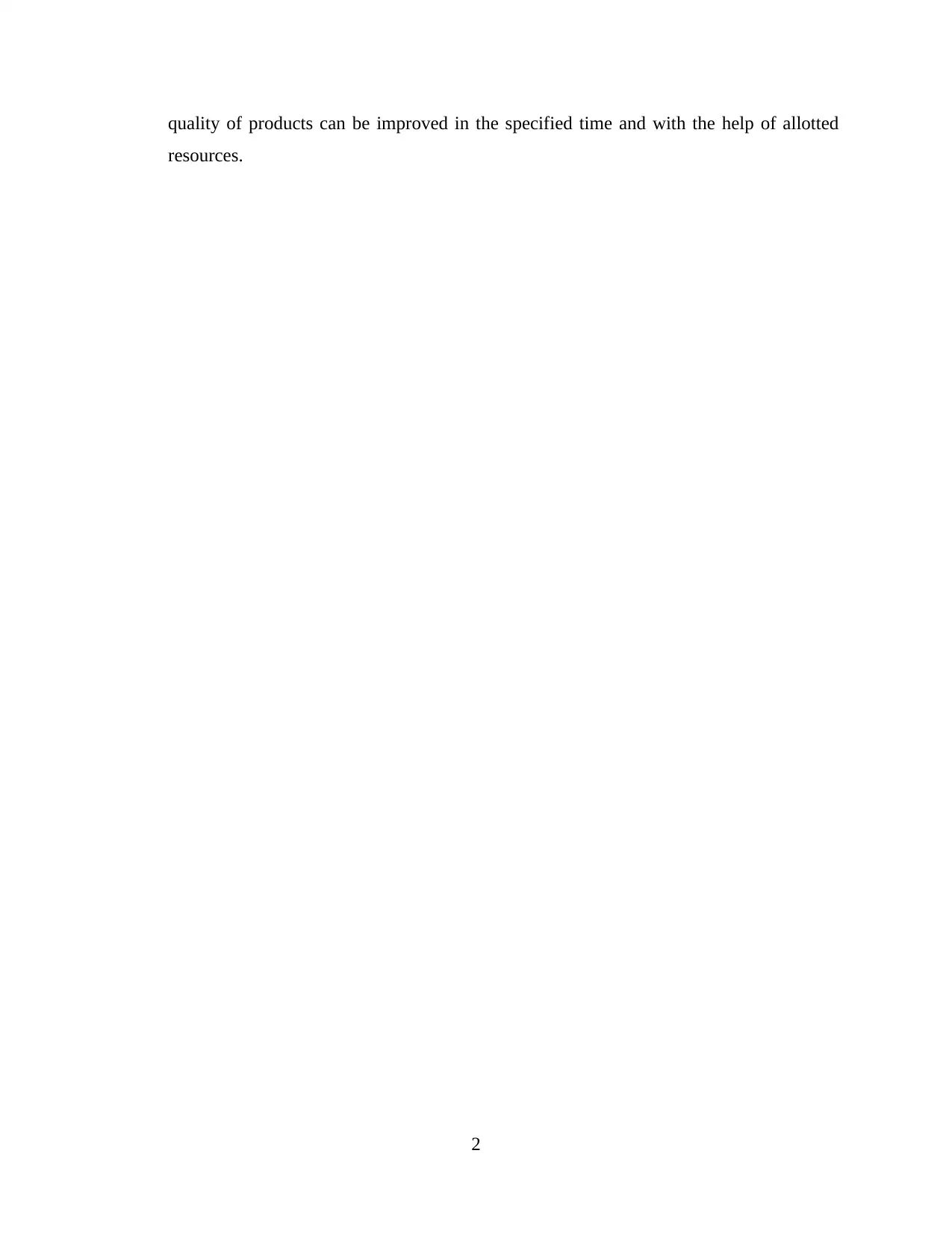
quality of products can be improved in the specified time and with the help of allotted
resources.
2
resources.
2
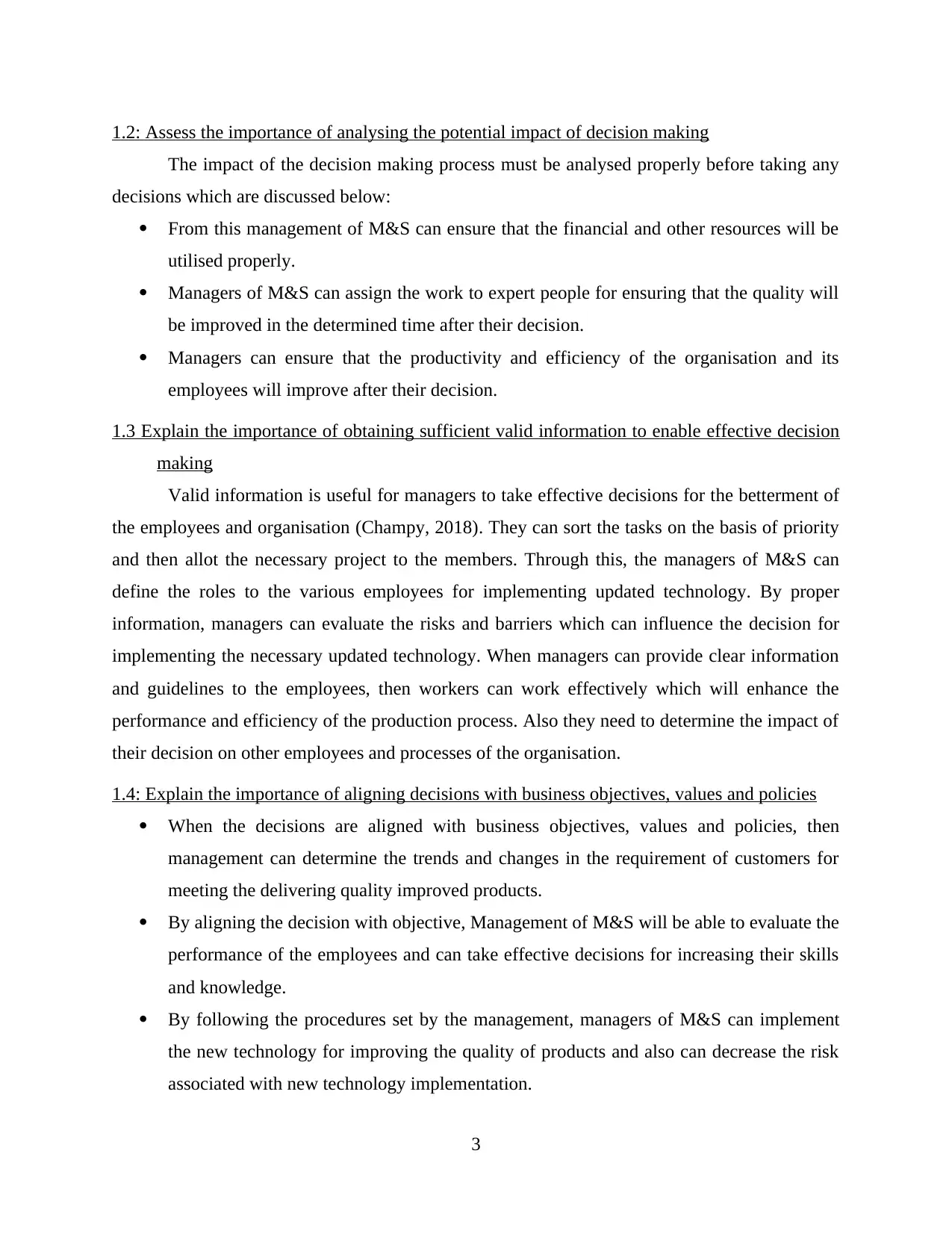
1.2: Assess the importance of analysing the potential impact of decision making
The impact of the decision making process must be analysed properly before taking any
decisions which are discussed below:
From this management of M&S can ensure that the financial and other resources will be
utilised properly.
Managers of M&S can assign the work to expert people for ensuring that the quality will
be improved in the determined time after their decision.
Managers can ensure that the productivity and efficiency of the organisation and its
employees will improve after their decision.
1.3 Explain the importance of obtaining sufficient valid information to enable effective decision
making
Valid information is useful for managers to take effective decisions for the betterment of
the employees and organisation (Champy, 2018). They can sort the tasks on the basis of priority
and then allot the necessary project to the members. Through this, the managers of M&S can
define the roles to the various employees for implementing updated technology. By proper
information, managers can evaluate the risks and barriers which can influence the decision for
implementing the necessary updated technology. When managers can provide clear information
and guidelines to the employees, then workers can work effectively which will enhance the
performance and efficiency of the production process. Also they need to determine the impact of
their decision on other employees and processes of the organisation.
1.4: Explain the importance of aligning decisions with business objectives, values and policies
When the decisions are aligned with business objectives, values and policies, then
management can determine the trends and changes in the requirement of customers for
meeting the delivering quality improved products.
By aligning the decision with objective, Management of M&S will be able to evaluate the
performance of the employees and can take effective decisions for increasing their skills
and knowledge.
By following the procedures set by the management, managers of M&S can implement
the new technology for improving the quality of products and also can decrease the risk
associated with new technology implementation.
3
The impact of the decision making process must be analysed properly before taking any
decisions which are discussed below:
From this management of M&S can ensure that the financial and other resources will be
utilised properly.
Managers of M&S can assign the work to expert people for ensuring that the quality will
be improved in the determined time after their decision.
Managers can ensure that the productivity and efficiency of the organisation and its
employees will improve after their decision.
1.3 Explain the importance of obtaining sufficient valid information to enable effective decision
making
Valid information is useful for managers to take effective decisions for the betterment of
the employees and organisation (Champy, 2018). They can sort the tasks on the basis of priority
and then allot the necessary project to the members. Through this, the managers of M&S can
define the roles to the various employees for implementing updated technology. By proper
information, managers can evaluate the risks and barriers which can influence the decision for
implementing the necessary updated technology. When managers can provide clear information
and guidelines to the employees, then workers can work effectively which will enhance the
performance and efficiency of the production process. Also they need to determine the impact of
their decision on other employees and processes of the organisation.
1.4: Explain the importance of aligning decisions with business objectives, values and policies
When the decisions are aligned with business objectives, values and policies, then
management can determine the trends and changes in the requirement of customers for
meeting the delivering quality improved products.
By aligning the decision with objective, Management of M&S will be able to evaluate the
performance of the employees and can take effective decisions for increasing their skills
and knowledge.
By following the procedures set by the management, managers of M&S can implement
the new technology for improving the quality of products and also can decrease the risk
associated with new technology implementation.
3
⊘ This is a preview!⊘
Do you want full access?
Subscribe today to unlock all pages.

Trusted by 1+ million students worldwide
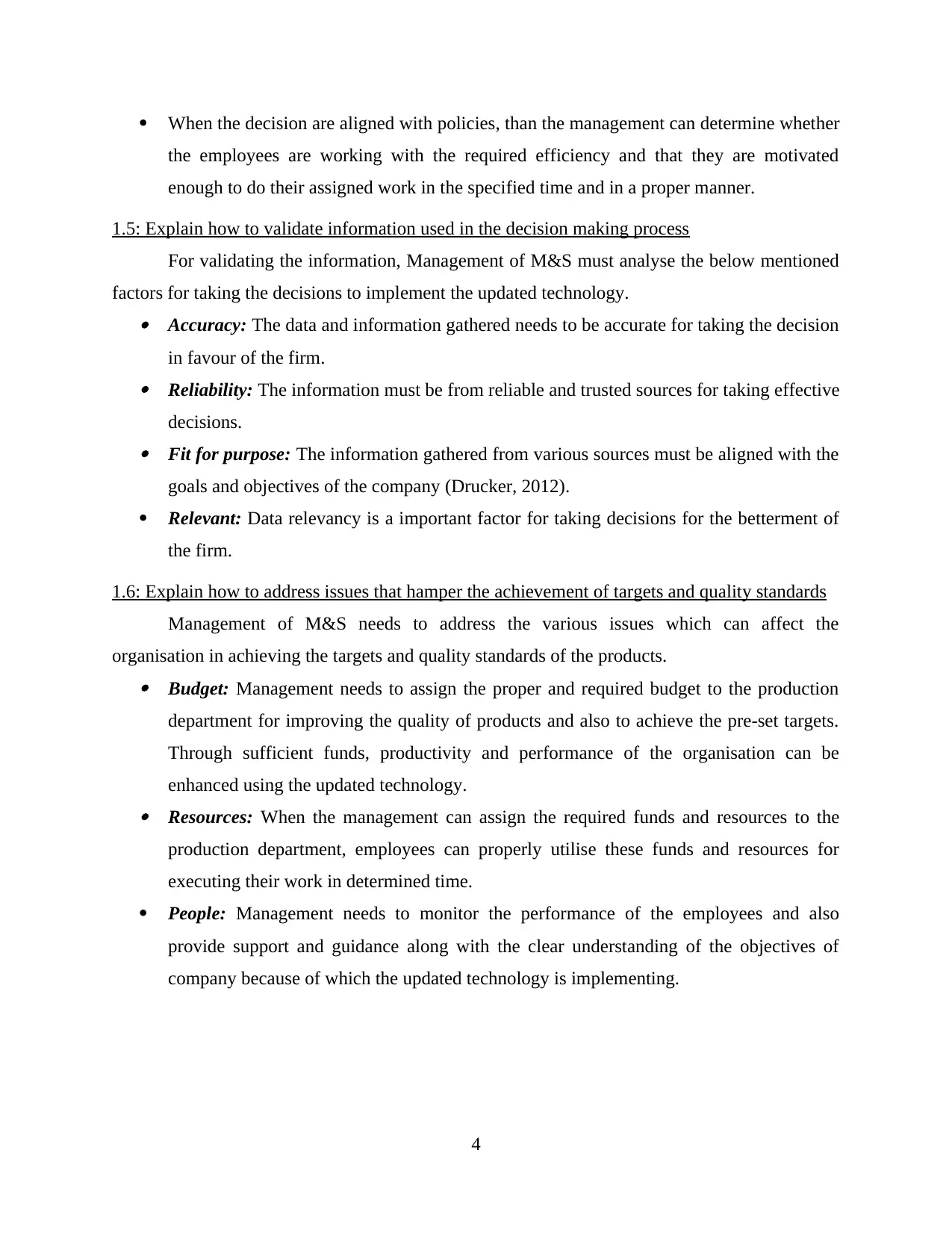
When the decision are aligned with policies, than the management can determine whether
the employees are working with the required efficiency and that they are motivated
enough to do their assigned work in the specified time and in a proper manner.
1.5: Explain how to validate information used in the decision making process
For validating the information, Management of M&S must analyse the below mentioned
factors for taking the decisions to implement the updated technology. Accuracy: The data and information gathered needs to be accurate for taking the decision
in favour of the firm. Reliability: The information must be from reliable and trusted sources for taking effective
decisions. Fit for purpose: The information gathered from various sources must be aligned with the
goals and objectives of the company (Drucker, 2012).
Relevant: Data relevancy is a important factor for taking decisions for the betterment of
the firm.
1.6: Explain how to address issues that hamper the achievement of targets and quality standards
Management of M&S needs to address the various issues which can affect the
organisation in achieving the targets and quality standards of the products. Budget: Management needs to assign the proper and required budget to the production
department for improving the quality of products and also to achieve the pre-set targets.
Through sufficient funds, productivity and performance of the organisation can be
enhanced using the updated technology. Resources: When the management can assign the required funds and resources to the
production department, employees can properly utilise these funds and resources for
executing their work in determined time.
People: Management needs to monitor the performance of the employees and also
provide support and guidance along with the clear understanding of the objectives of
company because of which the updated technology is implementing.
4
the employees are working with the required efficiency and that they are motivated
enough to do their assigned work in the specified time and in a proper manner.
1.5: Explain how to validate information used in the decision making process
For validating the information, Management of M&S must analyse the below mentioned
factors for taking the decisions to implement the updated technology. Accuracy: The data and information gathered needs to be accurate for taking the decision
in favour of the firm. Reliability: The information must be from reliable and trusted sources for taking effective
decisions. Fit for purpose: The information gathered from various sources must be aligned with the
goals and objectives of the company (Drucker, 2012).
Relevant: Data relevancy is a important factor for taking decisions for the betterment of
the firm.
1.6: Explain how to address issues that hamper the achievement of targets and quality standards
Management of M&S needs to address the various issues which can affect the
organisation in achieving the targets and quality standards of the products. Budget: Management needs to assign the proper and required budget to the production
department for improving the quality of products and also to achieve the pre-set targets.
Through sufficient funds, productivity and performance of the organisation can be
enhanced using the updated technology. Resources: When the management can assign the required funds and resources to the
production department, employees can properly utilise these funds and resources for
executing their work in determined time.
People: Management needs to monitor the performance of the employees and also
provide support and guidance along with the clear understanding of the objectives of
company because of which the updated technology is implementing.
4
Paraphrase This Document
Need a fresh take? Get an instant paraphrase of this document with our AI Paraphraser
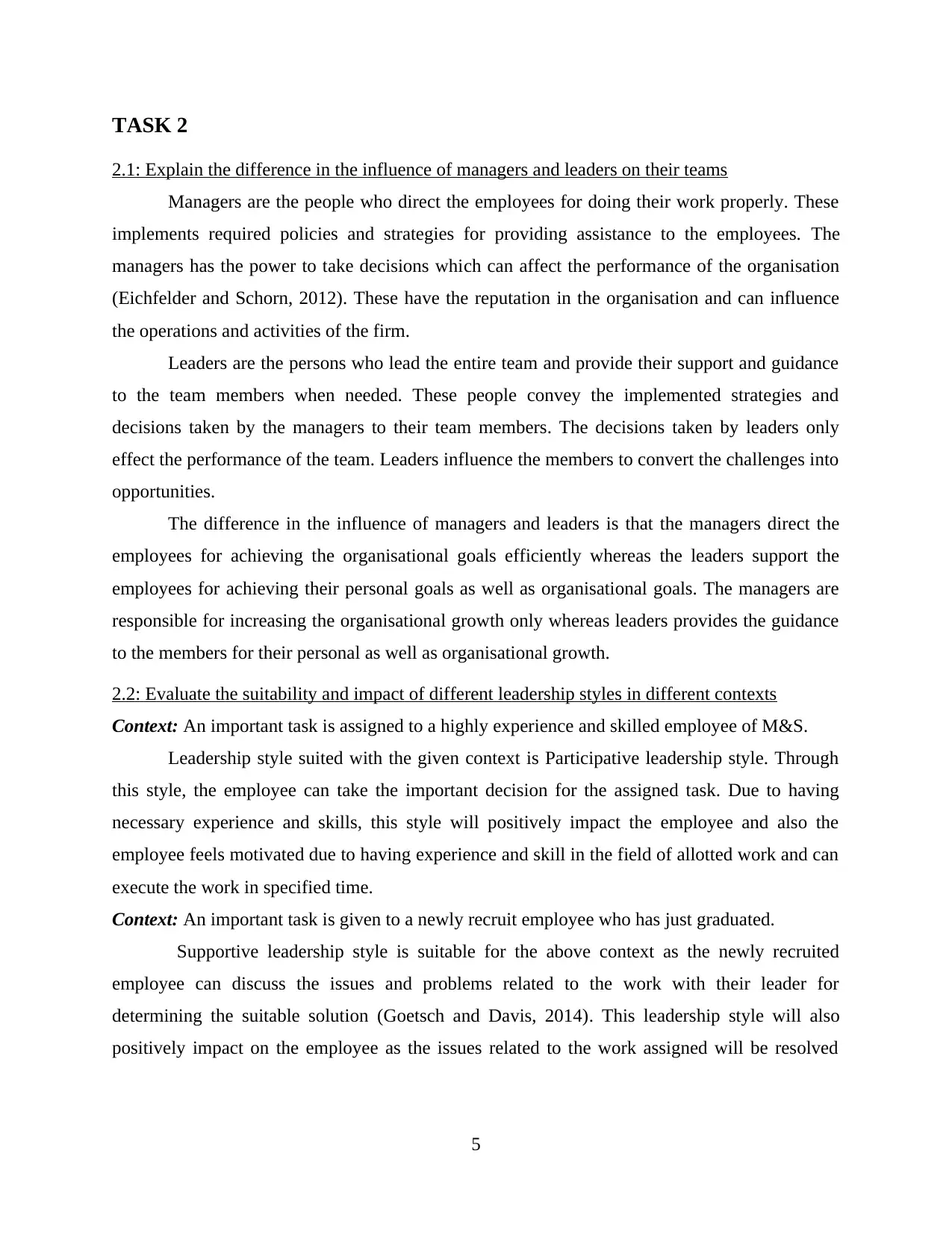
TASK 2
2.1: Explain the difference in the influence of managers and leaders on their teams
Managers are the people who direct the employees for doing their work properly. These
implements required policies and strategies for providing assistance to the employees. The
managers has the power to take decisions which can affect the performance of the organisation
(Eichfelder and Schorn, 2012). These have the reputation in the organisation and can influence
the operations and activities of the firm.
Leaders are the persons who lead the entire team and provide their support and guidance
to the team members when needed. These people convey the implemented strategies and
decisions taken by the managers to their team members. The decisions taken by leaders only
effect the performance of the team. Leaders influence the members to convert the challenges into
opportunities.
The difference in the influence of managers and leaders is that the managers direct the
employees for achieving the organisational goals efficiently whereas the leaders support the
employees for achieving their personal goals as well as organisational goals. The managers are
responsible for increasing the organisational growth only whereas leaders provides the guidance
to the members for their personal as well as organisational growth.
2.2: Evaluate the suitability and impact of different leadership styles in different contexts
Context: An important task is assigned to a highly experience and skilled employee of M&S.
Leadership style suited with the given context is Participative leadership style. Through
this style, the employee can take the important decision for the assigned task. Due to having
necessary experience and skills, this style will positively impact the employee and also the
employee feels motivated due to having experience and skill in the field of allotted work and can
execute the work in specified time.
Context: An important task is given to a newly recruit employee who has just graduated.
Supportive leadership style is suitable for the above context as the newly recruited
employee can discuss the issues and problems related to the work with their leader for
determining the suitable solution (Goetsch and Davis, 2014). This leadership style will also
positively impact on the employee as the issues related to the work assigned will be resolved
5
2.1: Explain the difference in the influence of managers and leaders on their teams
Managers are the people who direct the employees for doing their work properly. These
implements required policies and strategies for providing assistance to the employees. The
managers has the power to take decisions which can affect the performance of the organisation
(Eichfelder and Schorn, 2012). These have the reputation in the organisation and can influence
the operations and activities of the firm.
Leaders are the persons who lead the entire team and provide their support and guidance
to the team members when needed. These people convey the implemented strategies and
decisions taken by the managers to their team members. The decisions taken by leaders only
effect the performance of the team. Leaders influence the members to convert the challenges into
opportunities.
The difference in the influence of managers and leaders is that the managers direct the
employees for achieving the organisational goals efficiently whereas the leaders support the
employees for achieving their personal goals as well as organisational goals. The managers are
responsible for increasing the organisational growth only whereas leaders provides the guidance
to the members for their personal as well as organisational growth.
2.2: Evaluate the suitability and impact of different leadership styles in different contexts
Context: An important task is assigned to a highly experience and skilled employee of M&S.
Leadership style suited with the given context is Participative leadership style. Through
this style, the employee can take the important decision for the assigned task. Due to having
necessary experience and skills, this style will positively impact the employee and also the
employee feels motivated due to having experience and skill in the field of allotted work and can
execute the work in specified time.
Context: An important task is given to a newly recruit employee who has just graduated.
Supportive leadership style is suitable for the above context as the newly recruited
employee can discuss the issues and problems related to the work with their leader for
determining the suitable solution (Goetsch and Davis, 2014). This leadership style will also
positively impact on the employee as the issues related to the work assigned will be resolved
5
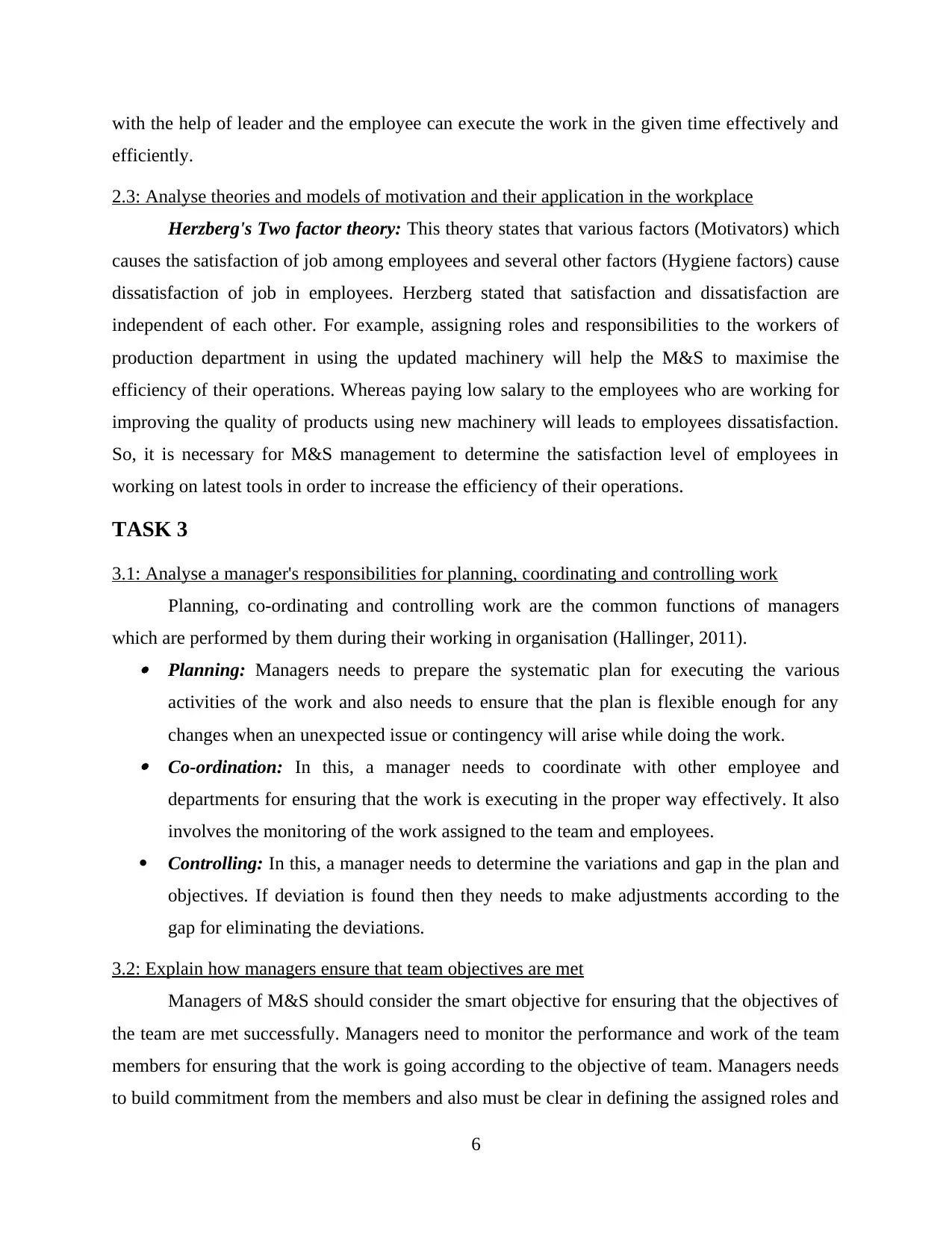
with the help of leader and the employee can execute the work in the given time effectively and
efficiently.
2.3: Analyse theories and models of motivation and their application in the workplace
Herzberg's Two factor theory: This theory states that various factors (Motivators) which
causes the satisfaction of job among employees and several other factors (Hygiene factors) cause
dissatisfaction of job in employees. Herzberg stated that satisfaction and dissatisfaction are
independent of each other. For example, assigning roles and responsibilities to the workers of
production department in using the updated machinery will help the M&S to maximise the
efficiency of their operations. Whereas paying low salary to the employees who are working for
improving the quality of products using new machinery will leads to employees dissatisfaction.
So, it is necessary for M&S management to determine the satisfaction level of employees in
working on latest tools in order to increase the efficiency of their operations.
TASK 3
3.1: Analyse a manager's responsibilities for planning, coordinating and controlling work
Planning, co-ordinating and controlling work are the common functions of managers
which are performed by them during their working in organisation (Hallinger, 2011). Planning: Managers needs to prepare the systematic plan for executing the various
activities of the work and also needs to ensure that the plan is flexible enough for any
changes when an unexpected issue or contingency will arise while doing the work. Co-ordination: In this, a manager needs to coordinate with other employee and
departments for ensuring that the work is executing in the proper way effectively. It also
involves the monitoring of the work assigned to the team and employees.
Controlling: In this, a manager needs to determine the variations and gap in the plan and
objectives. If deviation is found then they needs to make adjustments according to the
gap for eliminating the deviations.
3.2: Explain how managers ensure that team objectives are met
Managers of M&S should consider the smart objective for ensuring that the objectives of
the team are met successfully. Managers need to monitor the performance and work of the team
members for ensuring that the work is going according to the objective of team. Managers needs
to build commitment from the members and also must be clear in defining the assigned roles and
6
efficiently.
2.3: Analyse theories and models of motivation and their application in the workplace
Herzberg's Two factor theory: This theory states that various factors (Motivators) which
causes the satisfaction of job among employees and several other factors (Hygiene factors) cause
dissatisfaction of job in employees. Herzberg stated that satisfaction and dissatisfaction are
independent of each other. For example, assigning roles and responsibilities to the workers of
production department in using the updated machinery will help the M&S to maximise the
efficiency of their operations. Whereas paying low salary to the employees who are working for
improving the quality of products using new machinery will leads to employees dissatisfaction.
So, it is necessary for M&S management to determine the satisfaction level of employees in
working on latest tools in order to increase the efficiency of their operations.
TASK 3
3.1: Analyse a manager's responsibilities for planning, coordinating and controlling work
Planning, co-ordinating and controlling work are the common functions of managers
which are performed by them during their working in organisation (Hallinger, 2011). Planning: Managers needs to prepare the systematic plan for executing the various
activities of the work and also needs to ensure that the plan is flexible enough for any
changes when an unexpected issue or contingency will arise while doing the work. Co-ordination: In this, a manager needs to coordinate with other employee and
departments for ensuring that the work is executing in the proper way effectively. It also
involves the monitoring of the work assigned to the team and employees.
Controlling: In this, a manager needs to determine the variations and gap in the plan and
objectives. If deviation is found then they needs to make adjustments according to the
gap for eliminating the deviations.
3.2: Explain how managers ensure that team objectives are met
Managers of M&S should consider the smart objective for ensuring that the objectives of
the team are met successfully. Managers need to monitor the performance and work of the team
members for ensuring that the work is going according to the objective of team. Managers needs
to build commitment from the members and also must be clear in defining the assigned roles and
6
⊘ This is a preview!⊘
Do you want full access?
Subscribe today to unlock all pages.

Trusted by 1+ million students worldwide
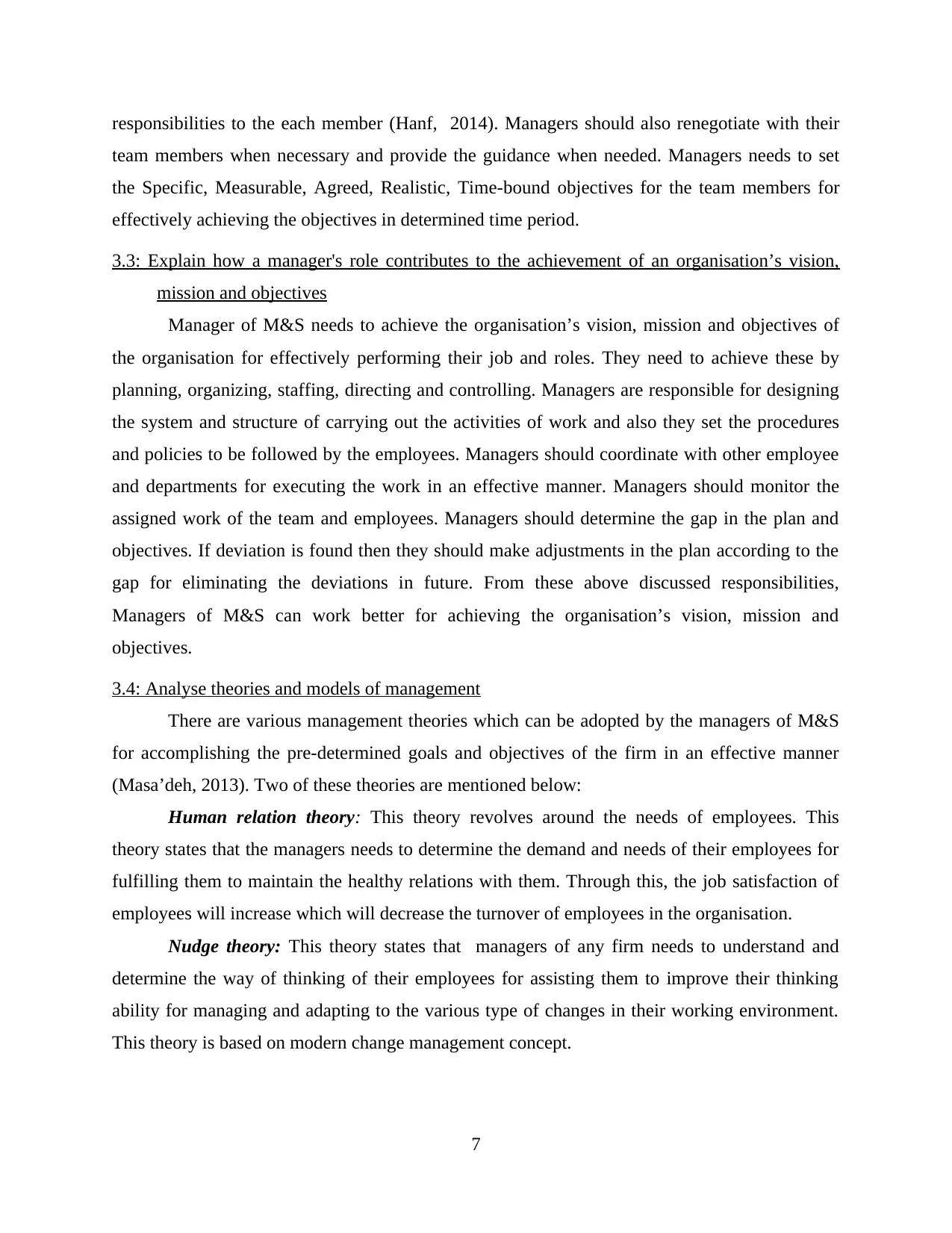
responsibilities to the each member (Hanf, 2014). Managers should also renegotiate with their
team members when necessary and provide the guidance when needed. Managers needs to set
the Specific, Measurable, Agreed, Realistic, Time-bound objectives for the team members for
effectively achieving the objectives in determined time period.
3.3: Explain how a manager's role contributes to the achievement of an organisation’s vision,
mission and objectives
Manager of M&S needs to achieve the organisation’s vision, mission and objectives of
the organisation for effectively performing their job and roles. They need to achieve these by
planning, organizing, staffing, directing and controlling. Managers are responsible for designing
the system and structure of carrying out the activities of work and also they set the procedures
and policies to be followed by the employees. Managers should coordinate with other employee
and departments for executing the work in an effective manner. Managers should monitor the
assigned work of the team and employees. Managers should determine the gap in the plan and
objectives. If deviation is found then they should make adjustments in the plan according to the
gap for eliminating the deviations in future. From these above discussed responsibilities,
Managers of M&S can work better for achieving the organisation’s vision, mission and
objectives.
3.4: Analyse theories and models of management
There are various management theories which can be adopted by the managers of M&S
for accomplishing the pre-determined goals and objectives of the firm in an effective manner
(Masa’deh, 2013). Two of these theories are mentioned below:
Human relation theory: This theory revolves around the needs of employees. This
theory states that the managers needs to determine the demand and needs of their employees for
fulfilling them to maintain the healthy relations with them. Through this, the job satisfaction of
employees will increase which will decrease the turnover of employees in the organisation.
Nudge theory: This theory states that managers of any firm needs to understand and
determine the way of thinking of their employees for assisting them to improve their thinking
ability for managing and adapting to the various type of changes in their working environment.
This theory is based on modern change management concept.
7
team members when necessary and provide the guidance when needed. Managers needs to set
the Specific, Measurable, Agreed, Realistic, Time-bound objectives for the team members for
effectively achieving the objectives in determined time period.
3.3: Explain how a manager's role contributes to the achievement of an organisation’s vision,
mission and objectives
Manager of M&S needs to achieve the organisation’s vision, mission and objectives of
the organisation for effectively performing their job and roles. They need to achieve these by
planning, organizing, staffing, directing and controlling. Managers are responsible for designing
the system and structure of carrying out the activities of work and also they set the procedures
and policies to be followed by the employees. Managers should coordinate with other employee
and departments for executing the work in an effective manner. Managers should monitor the
assigned work of the team and employees. Managers should determine the gap in the plan and
objectives. If deviation is found then they should make adjustments in the plan according to the
gap for eliminating the deviations in future. From these above discussed responsibilities,
Managers of M&S can work better for achieving the organisation’s vision, mission and
objectives.
3.4: Analyse theories and models of management
There are various management theories which can be adopted by the managers of M&S
for accomplishing the pre-determined goals and objectives of the firm in an effective manner
(Masa’deh, 2013). Two of these theories are mentioned below:
Human relation theory: This theory revolves around the needs of employees. This
theory states that the managers needs to determine the demand and needs of their employees for
fulfilling them to maintain the healthy relations with them. Through this, the job satisfaction of
employees will increase which will decrease the turnover of employees in the organisation.
Nudge theory: This theory states that managers of any firm needs to understand and
determine the way of thinking of their employees for assisting them to improve their thinking
ability for managing and adapting to the various type of changes in their working environment.
This theory is based on modern change management concept.
7
Paraphrase This Document
Need a fresh take? Get an instant paraphrase of this document with our AI Paraphraser
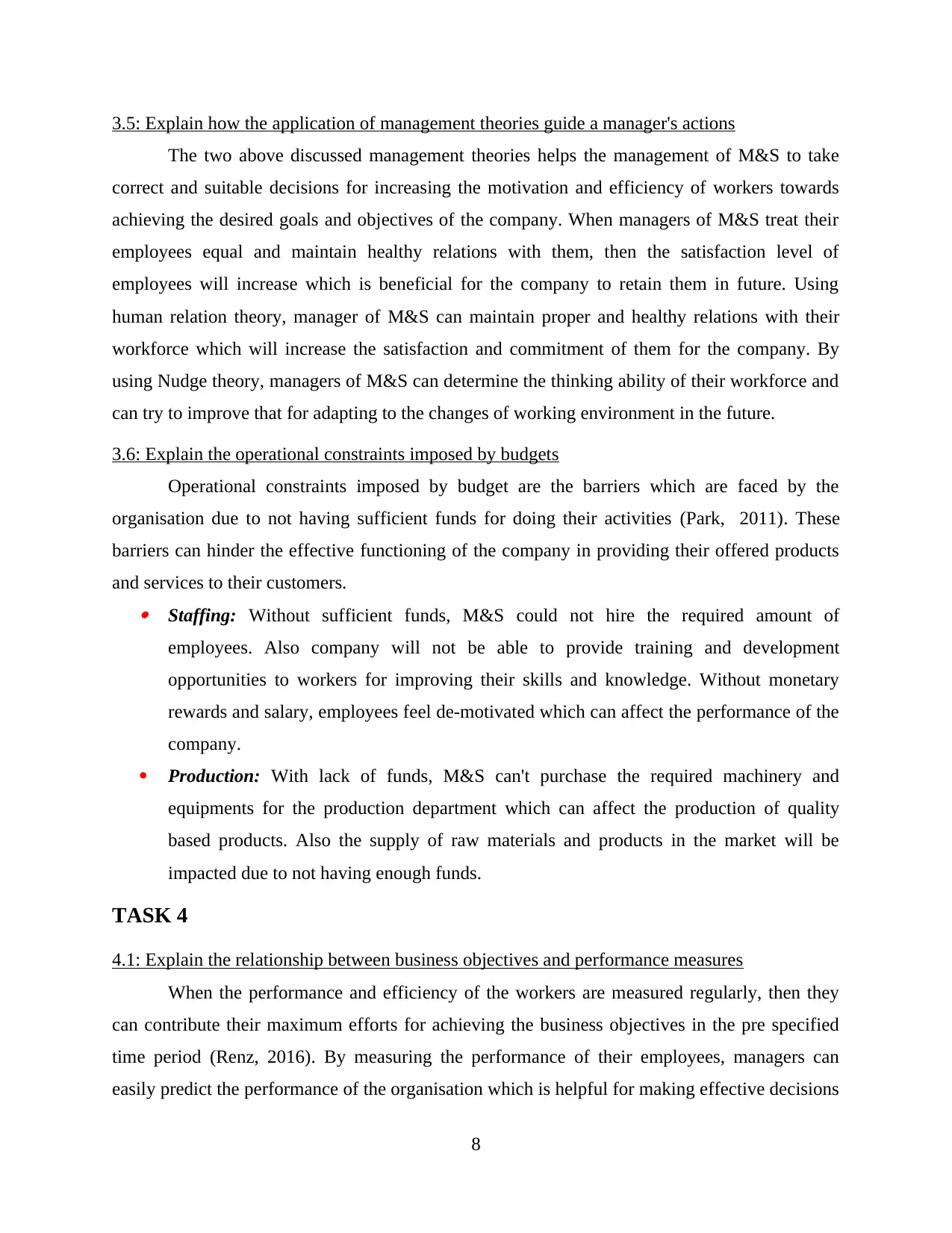
3.5: Explain how the application of management theories guide a manager's actions
The two above discussed management theories helps the management of M&S to take
correct and suitable decisions for increasing the motivation and efficiency of workers towards
achieving the desired goals and objectives of the company. When managers of M&S treat their
employees equal and maintain healthy relations with them, then the satisfaction level of
employees will increase which is beneficial for the company to retain them in future. Using
human relation theory, manager of M&S can maintain proper and healthy relations with their
workforce which will increase the satisfaction and commitment of them for the company. By
using Nudge theory, managers of M&S can determine the thinking ability of their workforce and
can try to improve that for adapting to the changes of working environment in the future.
3.6: Explain the operational constraints imposed by budgets
Operational constraints imposed by budget are the barriers which are faced by the
organisation due to not having sufficient funds for doing their activities (Park, 2011). These
barriers can hinder the effective functioning of the company in providing their offered products
and services to their customers. Staffing: Without sufficient funds, M&S could not hire the required amount of
employees. Also company will not be able to provide training and development
opportunities to workers for improving their skills and knowledge. Without monetary
rewards and salary, employees feel de-motivated which can affect the performance of the
company.
Production: With lack of funds, M&S can't purchase the required machinery and
equipments for the production department which can affect the production of quality
based products. Also the supply of raw materials and products in the market will be
impacted due to not having enough funds.
TASK 4
4.1: Explain the relationship between business objectives and performance measures
When the performance and efficiency of the workers are measured regularly, then they
can contribute their maximum efforts for achieving the business objectives in the pre specified
time period (Renz, 2016). By measuring the performance of their employees, managers can
easily predict the performance of the organisation which is helpful for making effective decisions
8
The two above discussed management theories helps the management of M&S to take
correct and suitable decisions for increasing the motivation and efficiency of workers towards
achieving the desired goals and objectives of the company. When managers of M&S treat their
employees equal and maintain healthy relations with them, then the satisfaction level of
employees will increase which is beneficial for the company to retain them in future. Using
human relation theory, manager of M&S can maintain proper and healthy relations with their
workforce which will increase the satisfaction and commitment of them for the company. By
using Nudge theory, managers of M&S can determine the thinking ability of their workforce and
can try to improve that for adapting to the changes of working environment in the future.
3.6: Explain the operational constraints imposed by budgets
Operational constraints imposed by budget are the barriers which are faced by the
organisation due to not having sufficient funds for doing their activities (Park, 2011). These
barriers can hinder the effective functioning of the company in providing their offered products
and services to their customers. Staffing: Without sufficient funds, M&S could not hire the required amount of
employees. Also company will not be able to provide training and development
opportunities to workers for improving their skills and knowledge. Without monetary
rewards and salary, employees feel de-motivated which can affect the performance of the
company.
Production: With lack of funds, M&S can't purchase the required machinery and
equipments for the production department which can affect the production of quality
based products. Also the supply of raw materials and products in the market will be
impacted due to not having enough funds.
TASK 4
4.1: Explain the relationship between business objectives and performance measures
When the performance and efficiency of the workers are measured regularly, then they
can contribute their maximum efforts for achieving the business objectives in the pre specified
time period (Renz, 2016). By measuring the performance of their employees, managers can
easily predict the performance of the organisation which is helpful for making effective decisions
8
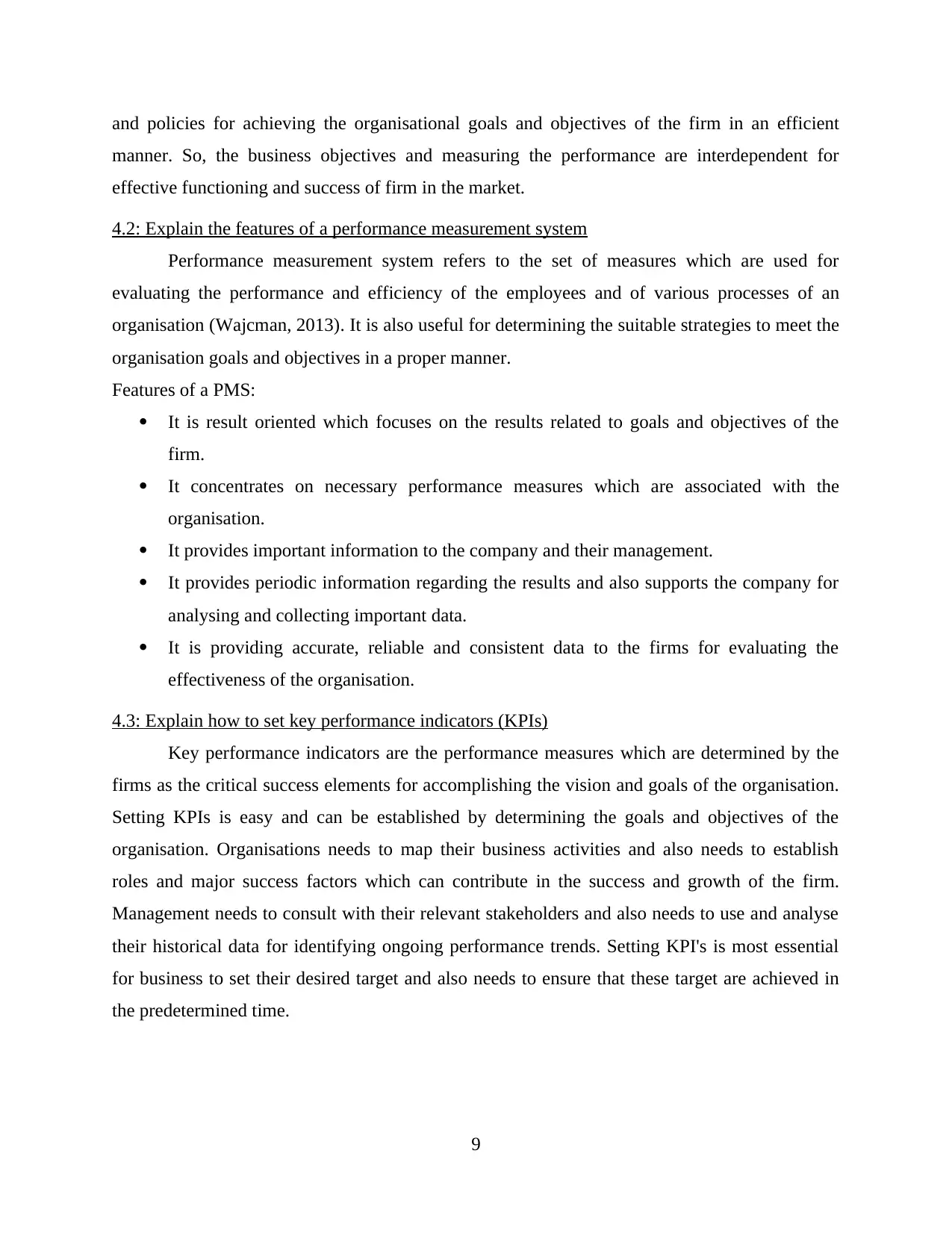
and policies for achieving the organisational goals and objectives of the firm in an efficient
manner. So, the business objectives and measuring the performance are interdependent for
effective functioning and success of firm in the market.
4.2: Explain the features of a performance measurement system
Performance measurement system refers to the set of measures which are used for
evaluating the performance and efficiency of the employees and of various processes of an
organisation (Wajcman, 2013). It is also useful for determining the suitable strategies to meet the
organisation goals and objectives in a proper manner.
Features of a PMS:
It is result oriented which focuses on the results related to goals and objectives of the
firm.
It concentrates on necessary performance measures which are associated with the
organisation.
It provides important information to the company and their management.
It provides periodic information regarding the results and also supports the company for
analysing and collecting important data.
It is providing accurate, reliable and consistent data to the firms for evaluating the
effectiveness of the organisation.
4.3: Explain how to set key performance indicators (KPIs)
Key performance indicators are the performance measures which are determined by the
firms as the critical success elements for accomplishing the vision and goals of the organisation.
Setting KPIs is easy and can be established by determining the goals and objectives of the
organisation. Organisations needs to map their business activities and also needs to establish
roles and major success factors which can contribute in the success and growth of the firm.
Management needs to consult with their relevant stakeholders and also needs to use and analyse
their historical data for identifying ongoing performance trends. Setting KPI's is most essential
for business to set their desired target and also needs to ensure that these target are achieved in
the predetermined time.
9
manner. So, the business objectives and measuring the performance are interdependent for
effective functioning and success of firm in the market.
4.2: Explain the features of a performance measurement system
Performance measurement system refers to the set of measures which are used for
evaluating the performance and efficiency of the employees and of various processes of an
organisation (Wajcman, 2013). It is also useful for determining the suitable strategies to meet the
organisation goals and objectives in a proper manner.
Features of a PMS:
It is result oriented which focuses on the results related to goals and objectives of the
firm.
It concentrates on necessary performance measures which are associated with the
organisation.
It provides important information to the company and their management.
It provides periodic information regarding the results and also supports the company for
analysing and collecting important data.
It is providing accurate, reliable and consistent data to the firms for evaluating the
effectiveness of the organisation.
4.3: Explain how to set key performance indicators (KPIs)
Key performance indicators are the performance measures which are determined by the
firms as the critical success elements for accomplishing the vision and goals of the organisation.
Setting KPIs is easy and can be established by determining the goals and objectives of the
organisation. Organisations needs to map their business activities and also needs to establish
roles and major success factors which can contribute in the success and growth of the firm.
Management needs to consult with their relevant stakeholders and also needs to use and analyse
their historical data for identifying ongoing performance trends. Setting KPI's is most essential
for business to set their desired target and also needs to ensure that these target are achieved in
the predetermined time.
9
⊘ This is a preview!⊘
Do you want full access?
Subscribe today to unlock all pages.

Trusted by 1+ million students worldwide
1 out of 15
Related Documents
Your All-in-One AI-Powered Toolkit for Academic Success.
+13062052269
info@desklib.com
Available 24*7 on WhatsApp / Email
![[object Object]](/_next/static/media/star-bottom.7253800d.svg)
Unlock your academic potential
Copyright © 2020–2025 A2Z Services. All Rights Reserved. Developed and managed by ZUCOL.




